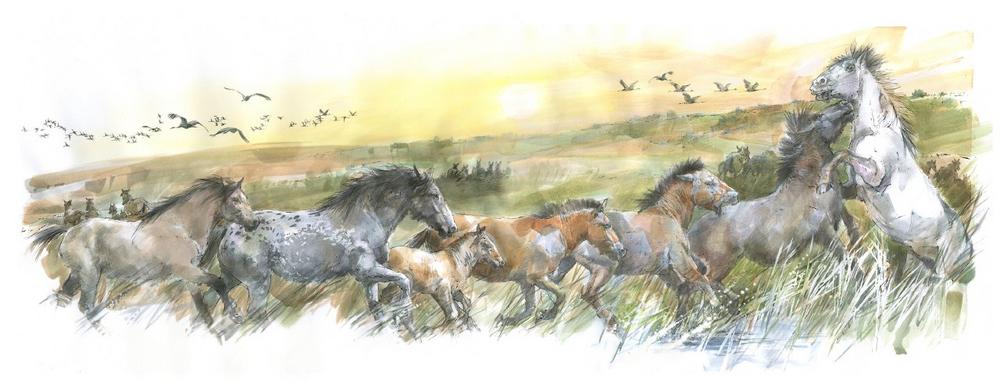Domestic and wild horses, donkeys and zebras all belong to the sole genus of the family Equidae still in existence today. But a look into the fossil record shows that over 35 different genera and hundreds of now extinct equine species occurred throughout the past. “This family is one of the most thoroughly researched animal groups in evolutionary history. Their fossils can be traced back over a period of around 55 million years,” explains Prof. Dr. Cosimo Posth from the Senckenberg Centre for Human Evolution and Palaeoenvironment at the University of Tübingen, and he continues, “For a long time, genetic research focused primarily on changes caused by the domestication of horses in the recent past. But to understand the evolution of the horse, you also have to examine their earlier history. Archeological finds, for example, show that horses already played a central role for early human species, particularly as a source of food.”
Together with doctoral students Arianna Weingarten and Meret Häusler, and a team of fellow researchers, the scientist from Tübingen, have for the first time, analysed mitochondrial genomes of the extinct horse species Equus mosbachensis from the Schöningen site in Lower Saxony. Weingarten, the study’s first author explains, “Schöningen is famous for its wooden spears which date back around 300,000 years ago and are the oldest known complete hunting weapons in the world. The fossil remains of at least 20 hunted horses were found right next to the spears – impressive evidence of the close relationship between humans and horses long before they were domesticated. Our study’s aim was to clarify the position and origin of Equus mosbachensis in the equine family tree and to better understand the genetic relationship to today’s horses.”
By analyzing well-preserved bone portions of the animal skeletons, using special molecular techniques and developing new bioinformatic methods for reconstructing genomes from ancient DNA, the team succeeded in piecing together genetic material that is around 300,000 years old – the oldest evidence of DNA under open-air conditions. “Until now, it was found that DNA could only be preserved for a maximum of around 240,000 years outside caves or permafrost. The Schöningen horses now push back this limit significantly,” says co-author Häusler, and she continues, “Normally, DNA decays quickly in open air contexts because temperature changes and microbes destroy the genetic material. But in Schöningen, the bones were preserved in permanently moist, low-oxygen sediments. This unique environment likely acted as natural protection.”
During the course of horse evolutionary history the ancestors of modern-day equids crossed the Bering Land Bridge, a mainland connection between Asia and North America, several times, thus spreading from North America to Eurasia. Two major waves of migration have been documented to date: The first, around 2.6 million years ago, brought the ancestors of today’s zebras and donkeys to the Eurasian and African continents. The second, around 900,000 to 800,000 years ago, introduced the so-called “caballine” horses. Many branches of the caballine family tree such as Equus mosbachensis, have become extinct. However, current investigations show that the horses sequenced at the Schöningen site belongs to the same evolutionary lineage as the horses that have survived to this day.
“With our study, we were able to fill a temporal and geographic gap in the study of horse evolution. Our results also show that surprisingly even in seemingly unfavorable environments, such as open-air excavation sites, extremely ancient DNA can still survive and be recovered. This opens up the possibility of extending our method to other species, thereby uncovering the genetic diversity of the distant past,” adds Posth in conclusion.
Senckenberg – Leibniz Institution for Biodiversity and Earth System Research // Senckenberg Gesellschaft für Naturforschung
Senckenberganlage 25
60325 Frankfurt
Telefon: +49 (69) 7542-0
Telefax: +49 (69) 746238
http://www.senckenberg.de
Senckenberg Centre for Human Evolution and Palaeoenvironment
Telefon: +49 (7071) 29-74089
E-Mail: cosimo.posth@uni-tuebingen.de
Senckenberg Centre for Human Evolution and Palaeoenvironment
Telefon: +49 (7071) 29-72416
E-Mail: nicholas.conard@uni-tuebingen.de
Universität Tübingen
Telefon: +49 (7071) 29-78981
E-Mail: kay.nieselt@uni-tuebingen.de
Leitung Pressestelle & Social Media
Telefon: 06975421434
E-Mail: judith.joerdens@senckenberg.de
![]()
